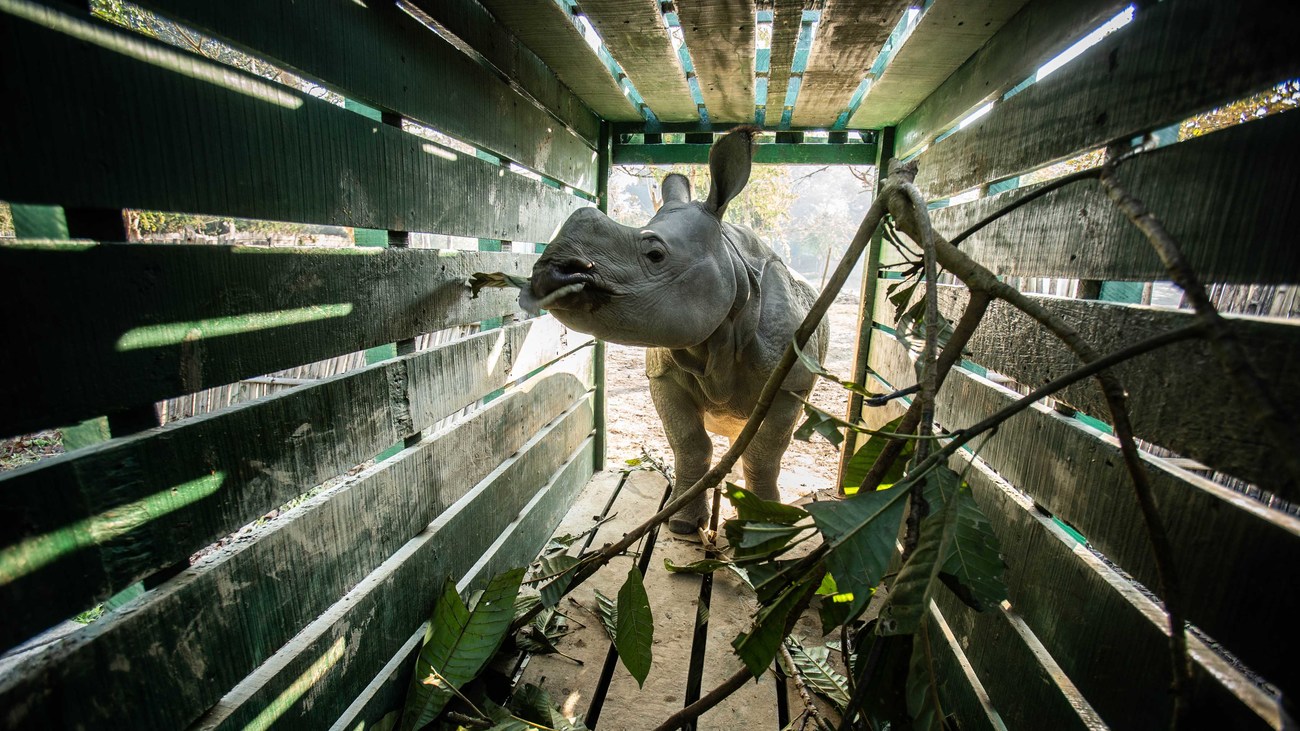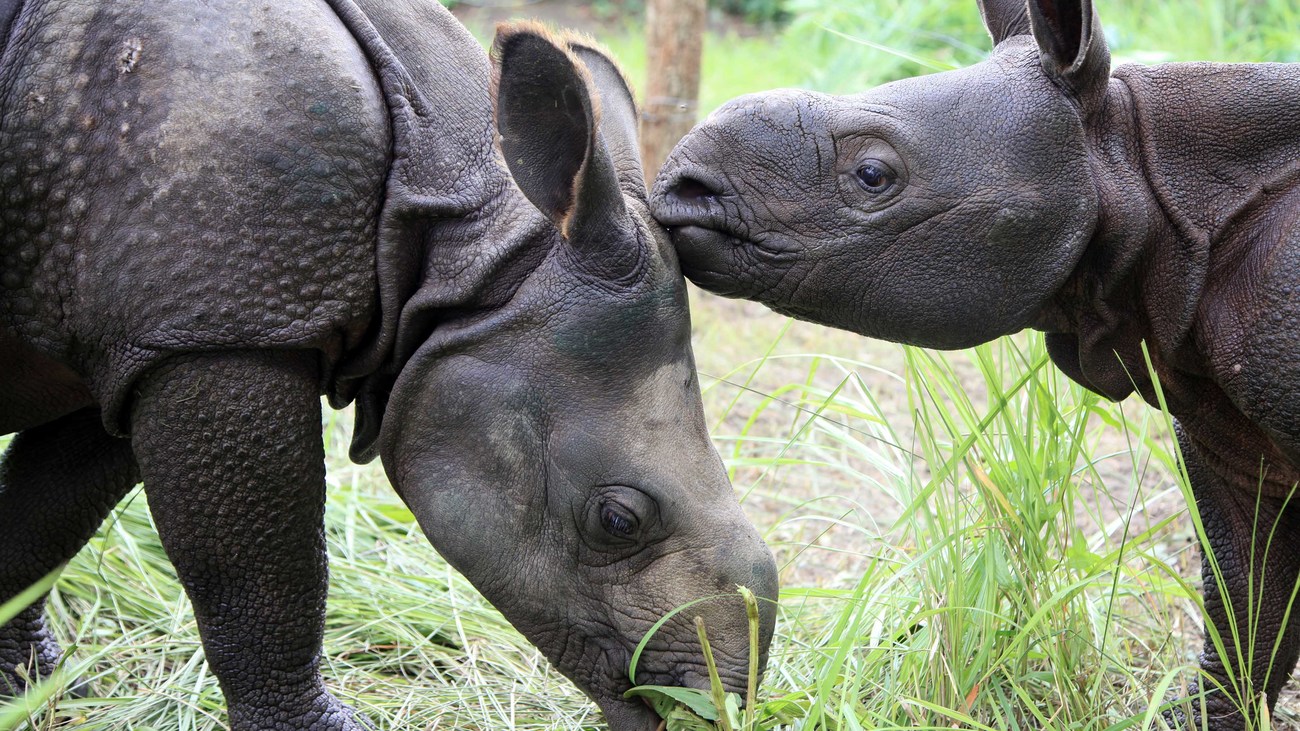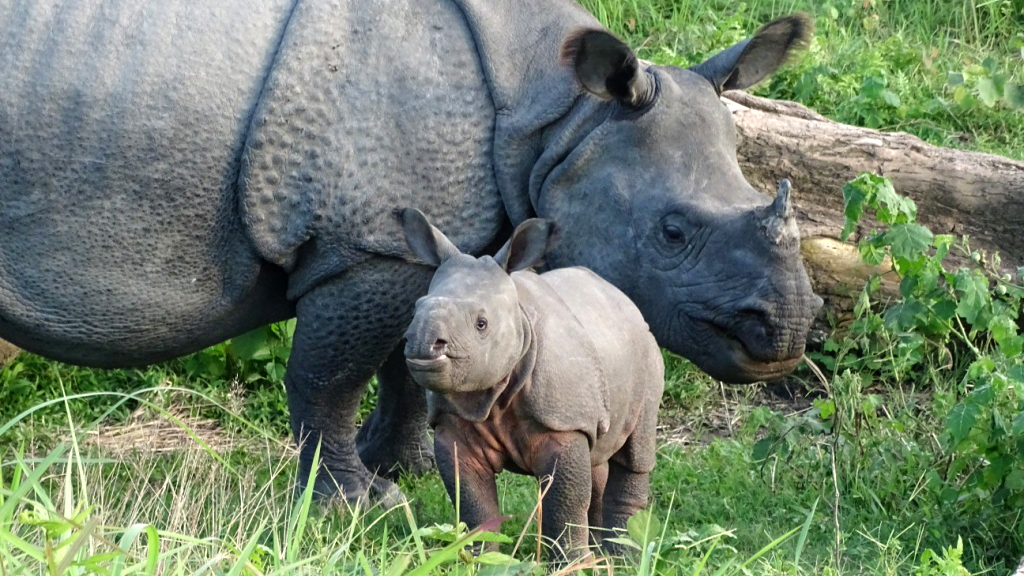Greater Manas Landscape Conservation - India
By restocking and enlarging a park, we restored its natural heritage and brought back the one-horned rhinoBringing rhinos back to Manas National Park
Bringing rhinos back to Manas National Park
In the 1990s, the greater one-horned rhino was on the verge of local extinction in India’s Manas Landscape. Today, an estimated total of 54 rhinos roam and thrive in the area and the population is steadily growing. Nearly 50% of this population is thanks to the work of IFAW and the Wildlife Trust of India (WTI). A leading factor in the incredible success of this project is the close partnership between IFAW and WTI—a partnership that’s been going strong for 20 years, a milestone we celebrated in 2021.

In the 1990s, the greater one-horned rhino was on the verge of local extinction in India’s Manas Landscape. Today, an estimated total of 54 rhinos roam and thrive in the area and the population is steadily growing. Nearly 50% of this population is thanks to the work of IFAW and the Wildlife Trust of India (WTI). A leading factor in the incredible success of this project is the close partnership between IFAW and WTI—a partnership that’s been going strong for 20 years, a milestone we celebrated in 2021.
“Consistency has made our partnership with the Wildlife Trust of India incredibly unique and has led to a tremendous impact for wildlife and communities in India,” said Meredith Whitney, an Animal Rescue Program Manager at IFAW. “Since this project first began in the early 2000s, we have maintained a consistent focus to restore rhino population in Manas National Park, rebuilding the population one rescued rhino at a time.
Our partnership to bring rhinos back to Manas National Park is a powerful example of how IFAW and our partners create impact through a rich combination of community engagement, animal rehabilitation and habitat conservation.
“We have helped rebuild a key population of greater one-horned rhinos in Manas National Park. Together with the Wildlife Trust of India, the Assam Forest Department and local government authorities, wild rhinos roam the park free and protected,” said Whitney.
Bringing back Manas
Manas National Park, a UNESCO World Heritage Site located in the far north of India and is one of India’s most important wildlife conservation areas. The grassland ecosystem is home to diverse wildlife, including tigers, Asian elephants, one-horned rhinos, golden langurs, swamp deer and clouded leopards.
Civil unrest in the 1980s and early 1990s left the landscape vulnerable to poaching, deforestation and fragmentation. Wildlife populations were severely impacted and nearly all of the park’s 100 rhinos were wiped out.
As the region stabilized, IFAW began working with WTI and the Assam Forest Department to repopulate the park and re-establish it as one of the most exceptional wildlife parks in the world through our Greater Manas Recovery Project.

Our approach to restoring rhino populations
Re-establishing rhinos is a priority as they act as a keystone species in the landscape and their recovery will benefit the grassland ecosystem and maintain ecological balance. However, rebuilding the population is especially challenging because rhinos are very territorial and adults moved from one habitat to another often fail to thrive. IFAW and our partners looked for a new approach.
The Kaziranga National Park, in the same northeast Indian state of Assam, is home to the world’s largest population of greater one-horned rhinos. Rhino calves sometimes get separated from their mothers in this area, often during biannual flooding that forces animals to seek higher ground. IFAW and WTI decided to rehabilitate orphaned rhino calves from Kaziranga and then release them into Manas when they are 2 or 3 years old, an age at which they are more able establish their own territory.
Rehabilitating orphaned calves
In 2002, IFAW, WTI and the Assam Forest Department established the Centre for Wildlife Rehabilitation and Conservation (CWRC) near Kaziranga National Park. It’s the only facility in India that rescues, hand-raises and rehabilitates animals such as one-horned rhinos and Asian elephants. Since it was established the CWRC has rescued more than 5,500 animals and released 3,500 back into the wild.
In an average year CWRC rescues around three rhino calves (though the number has been as high as 16 in one year). Orphaned calves are rehabilitated and raised until they can be moved to a soft-release facility in Manas before returning to the wild.
"The most meaningful part of this work is seeing the rhinos we’ve rescued become mothers of their own calves,” said Whitney. “The project teams monitor rescued rhinos for years after they have been released and we have seen at least two become mothers to multiple calves. This success was not overnight and took many years of focused research and work to achieve. Rhino calves can be difficult to rescue and rehabilitate—so to see rhinos we’ve rescued roam free and have their own calves is an incredible accomplishment.”

New calves are being born in Manas
One journey that illustrates the success of this approach is Ganga. Her mother was lost to flooding in 2004 when Ganga was just four months old. Carers at CWRC hand-raised her until she was released in Manas in 2007. She continues to thrive today and has given birth to four calves over the years, with the latest calf arriving in July 2021. Her calves are doing well too—she’s even a grandmother. To date, eight calves have been born to rhinos rehabilitated by CWRC and released in Manas.
Protecting habitat together with local communities
Rhinos in Manas remain threatened by poaching and human-animal conflict when they enter communities. IFAW and WTI have initiated community-based conservation activities and alternate livelihoods. We are also working with local communities to boost anti-poaching efforts and to train and equip rangers. By inspiring local children through dedicated campaigns, a new generation is learning to take pride in their natural heritage.
The Assam government in India sent a strong anti-poaching message on World Rhino Day in 2021 by burning almost 2,500 rhino horns, most of which were seized from poaching and illegal trade. The destruction of such stockpiles sends a message that live rhinos and their habitats should be valued, not the killing of rhinos for their horns.

Expanding Manas to conserve more habitat
The partnership between IFAW and WTI has made huge progress in ensuring that rhinos and other wildlife have a safe and secure habitat. Together we were instrumental in getting the Manas National Park expanded by 350 square kilometers in 2016. In 2021 together we helped add another 422 square kilometers of protected land to the Greater Manas Landscape with the designation of Raimona National Park. This park runs contiguous to two protected areas in Bhutan, facilitating habitat connectivity and supporting wildlife movement between the areas.
"This project has demonstrated that progress is possible,” said Whitney. “With teamwork, consistency and incredible supporters, positive change is within our reach. The challenges we face in our world today are urgent, complicated and, often, resistant to change. But the story of this project and the success of our long-term partnership with WTI proves that together we can make a difference for animals and people in our world.”
Related content
Our work can’t get done without you. Please give what you can to help animals thrive.